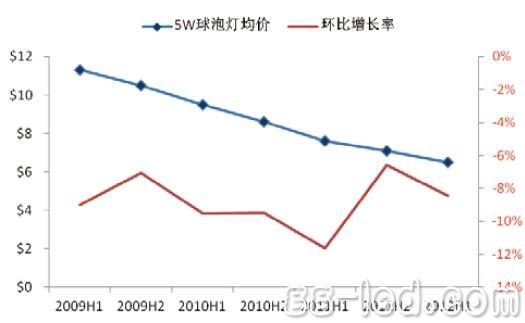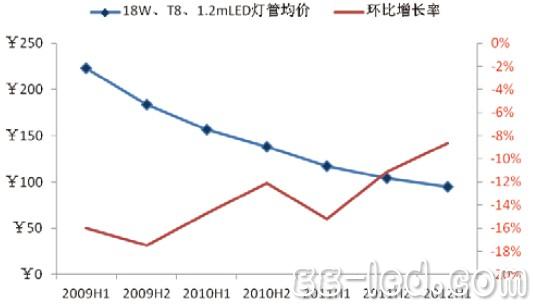According to the latest report released by the High-tech LED Industry Research Institute (GLII), since the first half of 2011, China has added nearly 1,800 new LED indoor lighting companies. Among them, in the first half of this year alone, there were nearly 1,000 new companies. In terms of market size, the data shows that in the first half of this year, the overall size of China's LED indoor lighting market increased by nearly 36% year-on-year.
In terms of product prices, in the first half of this year, the domestic LED indoor lighting products prices fell by about 10% on average, of which the prices of products exported to Europe and the United States fell by 8%-10%, while the prices of products exported to the Japanese market were relatively stable, with a decrease. Between 5% and 8%.
As of the end of June 2012, the ex-factory price of LED bulbs replacing 40-watt incandescent lamps in the domestic market has dropped to 35 yuan.
Market size increased by 36% year-on-year
According to the GLII report, in the first half of 2012, China's LED indoor lighting market grew rapidly, with a year-on-year increase of nearly 36%. Among them, the sales of LED lamps, LED bulbs, LED downlights and LED spotlights increased significantly. It is estimated that in 2012, the scale of China's LED indoor lighting market will exceed 25 billion yuan, a year-on-year growth rate of more than 40%.
According to the survey, in the first half of this year, more than 1,800 new LED indoor lighting companies were added, of which more than 60% of the new companies entered the LED display and LED packaging industry.
Due to the slowdown in the growth of the LED display market in recent years, related companies generally face the problem of how to achieve business transformation. As the largest LED application market in the future, indoor lighting has naturally become the first choice for many LED display companies.
In addition to Zhouming Technology, Lianjian Optoelectronics and other display companies that have entered the LED indoor lighting market, Regent Optoelectronics, Sangaoke and other old LED display companies have also accelerated the development of LED lighting business. At the same time, as the largest domestic display company with the largest revenue, Shanghai Sansi has also begun to research and develop LED indoor lighting products, and plans to launch LED indoor lighting products next year.
Ex-factory price decreased by 10%
According to the GLII report, since the first half of this year, the price of LED indoor lighting products in China has shown a slight downward trend, with a drop of less than 10%. The ex-factory price of 5W LED bulbs with a luminous flux between 420-450lm has dropped to about 6.5 US dollars; luminous flux The ex-factory price of 18W, 1.2m, T8 LED tubes at around 1600lm has dropped below 100 yuan; the ex-factory price of 3W LED spotlights MR16 with a luminous flux of around 240lm has dropped to around $3.
At present, LED indoor lighting manufacturers in the domestic market sales, still to undertake commercial and government transformation projects, product prices have not seen a significant decline, the gross profit margin of undertaking projects can be maintained at more than 30%.
In the export market, the demand growth in the overseas market slowed down due to the continued economic downturn in the overseas market. At the same time, the competition of domestic LED indoor lighting manufacturers has intensified, resulting in different levels of product ex-factory prices, with an overall decline of less than 10%. Among them, the price of LED indoor lighting products exported to Japan decreased by 5%-8%, while the prices of LED indoor lighting products exported to Europe, North America, South America and the Middle East fell by 8%-10%. between.
Figure 1 2009H1-2012H1 5W LED Bulbs Average Ex-factory Price Trends Increased by 10% YoY

Source: Gaogong LED Industry Research Institute
Figure 2 2009H1-2012H1 18W T8 1.2mLED tube average ex-factory price trend

Source: Gaogong LED Industry Research Institute

USB3.0 provides a standard interface for all kinds of devices that are connected to PCS or audio/high-frequency devices.The theoretical transmission speed is up to 5Gbps. HUB is commonly known as a hub, which is used to connect multiple computers or network devices in a network using a star topology. The USB 3.0 Hubs is an upgrade of the USB 2.0 Hubs. The transmission rate of the USB2.0 is 480Mbps, and the transmission rate of the USB3.0 is 5Gbps. The maximum transmission speed is 10 times that of the USB2.0, and the transmission speed is faster.
The USB 3.0 hub provides a quick and easy way to connect all the peripherals you use on your desktop. You can connect 2 external monitors, gigabit Ethernet ports, headphones/speakers, USB printers and scanners, keyboards, mice and other peripherals with a single USB 3.0 cable to your computer for up to 5Gbit/s external storage access (10 times faster than USB 2.0). USB HUBS can do split, but not evenly. If, as the subject says, you only have two devices, and the two devices are transmitting at the same time and taking up as much bandwidth as possible, then you end up with two devices each taking up 50% of the bandwidth. Due to the fast theoretical speed of USB3.0, even if divided into four parts, the theoretical bandwidth of each port is still as high as 1Gbps, and the number of converted bytes is close to 100MB/s, which is still a very high bandwidth.

Usb 3.0 Hubs,Wireless Usb Hub,Usb C Hub For Desktop,All In One Usb C Hub
Henan Yijiao Trading Co., Ltd , https://www.yjusbcable.com
